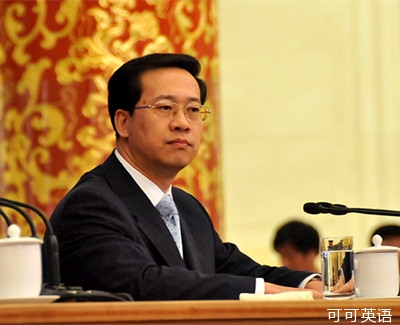China is Australia’s Land of Opportunity
澳大利亞經濟的新機遇
On January 31, 2014, the Chinese ambassador to Australia MA Zhaoxu published in The Australian Financial Review a signed article with the title of “China is Australia’s land of opportunity”. The full text is as follows
2014年1月31日,中國駐澳大利亞大使馬朝旭在當地主流媒體《澳大利亞金融評論報》發表題為《澳大利亞經濟的新機遇》的署名文章。全文如下:
Last week China released economic data for 2013, which shows GDP grew by 7.7 per cent, a mid-to-high growth rate in global terms. More than 13 million new urban jobs were created, more than in any previous year. Total imports approached $US2 trillion. Overseas direct investment by Chinese enterprises exceeded $US90 billion. Given the lingering international financial crisis, the unrecovered world economy and China’s effort of economic restructuring, such a “score report” is a hard-won achievement. Moreover, with uncertainties in the global economy and unusual sensitivities of the international market to macro-policy developments in major economies, China’s stable fiscal and monetary policies as well as reasonable liquidity have sent a clear signal of stability to international market expectations. This is an act of responsibility by China in the interest of the world economy.
上周中國國家統計局發布數據顯示,2013年中國國內生產總值(GDP)增長了7.7%。這個數字從全球范圍看,保持了中高速增長。全年城鎮新增就業人數超過1300萬,是歷年最多的。去年中國進口額接近2萬億美元,中國企業對外直接投資也超過了900億美元。這一成績來之不易,是在國際金融危機余波未平、世界經濟尚待復蘇和中國經濟轉型升級的背景下產生的。在世界經濟不確定因素較多、國際市場對主要經濟體宏觀政策動向異常敏感的情況下,中國穩定財政、貨幣政策,保持合理的流動性,向國際市場發出了明確的穩定預期的信號,這也是中國對世界經濟發展的負責任之舉。
The figures also mean an upgrading of China’s economic growth and show that huge opportunities may arise for the global and the Australian economy. China’s service sector accounted for 46.1 per cent of the country’s GDP in 2013, up from 44.6 per cent in 2012, outperforming the industrial sector for the first time. The service sector has become a new growth engine, setting economic growth on a healthier, long-term trajectory. China-Australia co-operation in the service sector is moving forward fast. China has been Australia’s largest export market for service products for three years in a row. Our two-way trade in services reached $8.5 billion and Australia exported $6.7 billion worth of service products to China in 2012-2013.
China is Australia’s largest source of international students, second-largest source of inbound tourists as well as the fastest-growing inbound tourism market. Far-sighted Australian enterprises have been capitalising on opportunities provided by the new momentum. ANZ won approval for a sub-branch in the Shanghai Free Trade Zone last November. Andrew Whitford, Westpac’s head of Greater China, said Australian companies should establish themselves in the new zone as there are “enormous opportunities”.
新公布的數據也釋放出中國經濟增長結構優化,以及這種轉變對世界和澳大利亞經濟帶來巨大機遇的積極信息。根據中國國家統計局的數據,第三產業占中國GDP比重從2012年的44.6%上升為2013年46.1%,首次超過以工業、采礦業、建筑業為代表的第二產業。中國的經濟已由過去依靠制造業的“單輪驅動”發展到如今制造業、服務業雙增長的“雙輪驅動”,服務業正成為中國經濟長期持續健康發展與優化升級的新引擎和新動力。中澳服務業合作正處于快速發展時期。中國已連續3年成為澳最大的服務產品出口市場。2012-2013財年雙邊服務貿易近85.3億澳元,其中,澳對華出口66.6億澳元。中國已成為澳大利亞最大的留學生來源國、第二大海外游客來源國,也是增長最快的旅客市場。一些有戰略眼光的澳大利亞企業已經敏銳捕捉到了商機。澳新銀行在去年11月正式登陸上海自貿區。西太銀行大中華區總裁魏安德認為,澳洲企業應當考慮將進駐上海新自貿區作為與中國投資者產生聯系的一種方式。
In 2013, the GDP of central and western parts of China was 44 per cent of China’s total, up by 0.2 per cent on the previous year. The per capita net income of rural residents grew by 9.3 per cent in real terms, 2.3 per cent higher than that of urban residents. The income gap between urban and rural residents shrank from 3.10 in 2012 to 3.03. This trend for four consecutive years is a sign that regional development disparity has been easing, unleashing huge market potential for the vast hinterland areas. Australian enterprises have been increasingly active in the development of central and western China, which will help Australia gain a head start in China’s economic restructuring.
2013年,中國中西部地區GDP總量占全國的44.4%,比2012年提高0.2個百分點。中國農村居民人均純收入實際增長9.3%,比城鎮居民人均可支配收入實際增速高2.3個百分點,增速連續四年快于城鎮,城鄉居民人均收入倍差由上年的3.10縮小為3.03。這些數據表明長期困擾中國經濟發展的城鄉失衡、區域失衡問題正得到逐步緩解,中國龐大的中西部和農村市場潛力正不斷釋放。我們看到,澳企業正日益積極地參與到中國西部地區的發展中來。我相信這將幫助澳在中國經濟轉型中占得先機。
Despite a softening of its economy, with 2013 growth the same as 2012, China still has robust demand for Australian energy and resources. China’s economic aggregate is now on a much larger base than before, with a GDP of US$9.18 trillion, the second largest economy for four years running. A larger, better-quality and more stable Chinese economy will bring even more opportunities to the world. The urbanisation rate rose by 1.16 per cent to 53.73 per cent in 2013 which shows China still has a large demand for infrastructure building.
中國對澳能源資源等需求依然強勁穩健。盡管2013年中國經濟增速與2012年持平,較過去有所下降,但總體增量卻比以前要大得多。中國GDP總量已經達到9.18萬億美元,連續4年成為世界第二大經濟體。一個總量更大、增長質量更高、增長速度更穩的中國經濟將為世界、為澳大利亞帶來更多機遇。2013年,中國城鎮化率同比提高1.16%,達53.73%,并有望在未來十年保持年均1.2%的提升速度。中國仍需進行大量的基礎設施建設。
China’s outbound trade and investment will continue to expand with outbound investment expected to reach $US500 billion over five years. This is good news to Australian businesses in energy, resources and agriculture. This year is going to be vital to world economic recovery. It will also be an important year for upgrading China-Australia economic ties. Both nations should work together to seize new opportunities and fully tap co-operation potential.
同時,中國對外貿易與投資不斷擴大,未來五年,中國對外投資規模將達到5000億美元。這對于澳能源資源的開發與出口、農產品國際市場的開拓等,無疑都是好消息。
2014年是世界經濟走向復蘇的重要年份,也是中澳經貿合作升級發展的關鍵一年。中澳雙方應該攜手努力,發掘合作潛力,為兩國人民帶來更多實實在在的利益。

更多精品翻譯素材,敬請關注可可英語。











